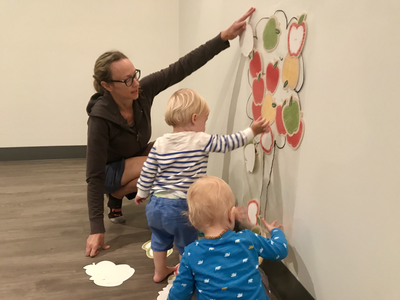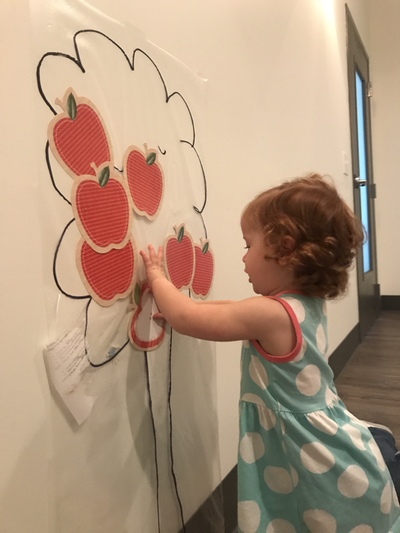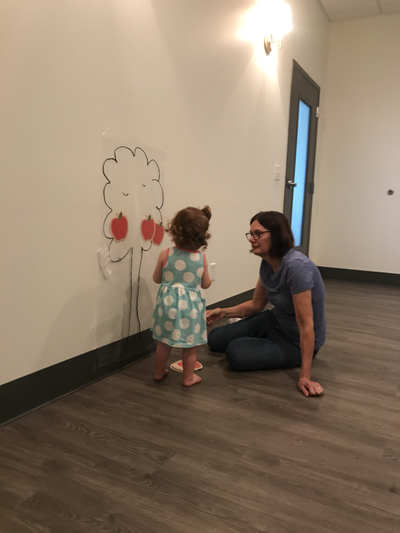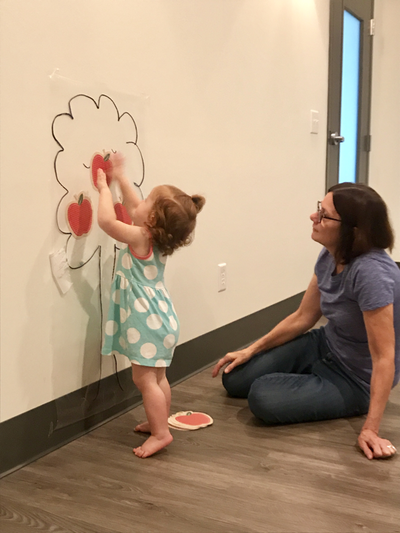Fun foundations class: Apples
Some tidbits about APPLES:
**Keep in mind: RAW apple is a big choking hazard for children who do not yet have matching molars (a matching top + bottom molar that can be used to chew food). For this reason, please finely dice raw apple, cook it, mash it or put in a mesh feeding bag.
- APPLE is a trickier first word for early talkers because:
- it starts with a vowel and most first words start with consonants
- it is 2 syllables where both syllables sound different. 1-syllable words are the easiest for early talkers, followed by 2-syllable words with the same syllable (e.g. mama, dada, baba), then 2-syllable words with the same initial consonant (e.g. puppy, nana).
- the "l" sound is a later-developing sound (typically mastered by children around 4-5 years old), so if a child does say this word, it will likely sound like "apuh." See here for more info about when many sounds are mastered (note there are different pages for boys vs. girls).
- For all these reasons, it is a great sign to teach! See below.
**Keep in mind: RAW apple is a big choking hazard for children who do not yet have matching molars (a matching top + bottom molar that can be used to chew food). For this reason, please finely dice raw apple, cook it, mash it or put in a mesh feeding bag.
Signs we learned in class:
skills + strategies discussed in class
Imitation: This is another indirect language facilitation strategies for your language-boosting toolbox. An indirect language facilitation strategy is where we build around a child's utterance (what the child says) and do NOT require a response from the child.
All you have to do is IMITATE your baby. It really is that easy!
Here's a printable handout with this same information.
Step 1: Make the same sounds and movements that your baby does. If he is saying “oooooh,” wait until he is done, then you say “oooooh.” If she is clapping, wait until she is done and then you clap! It’s really as easy as it sounds.
Step 2: Once your little one realizes that you are doing this, they will be interested! Continue to take turns talking/moving in a back-and-forth manner until they lose interest.
Step 3: After your kiddo has gotten the hang of this game (could be hours, days or weeks after you started, depending on their age), start by imitating them several times, then change up the sound/action just a little bit to encourage them to now imitate you.
Example 1:
baby: “babababa” you: “babababa”
baby: “babababa” you: “babababa”
baby: “babababa” you: “mamamama”
Example 2:
baby: bangs block on table you: bangs block on table
baby: bangs block on table you: bangs block on table
baby: bangs block on table you: bangs block on hand
Games like pushing cars back and forth, putting shapes in a shape sorter, or blowing bubbles are all great activities for implementing turn-taking and imitation. It is easy to manipulate those activities for “my turn,” “your turn,” as well as adding a sound to each part of the activity. When you add a sound or word like, “in” while putting a shape in the shape sorter, try giving your child a little extra time to imitate you before you take another turn. I sometimes cover the hole on the shape sorter and look at them expectantly until they make some kind of attempt at imitation, then I uncover the hole and reinforce their attempt by saying something like, “in, you said in!” Try manipulating your play a little to allow for more turn-taking and imitation and I’m sure you will be excited to find out what your little ones are truly capable of.
A longer example:
I was sitting with my 10-month-old son on the floor to play with a set of balls. He had a ball in his hand and he was shaking it while saying, “aaaah, aaaah.” I picked up a nearby ball and shook it in the same manner and made the same sound, “aaaah, aaaah.” He immediately looked up at me as if to say, “Hey, you want to play?” And we did.
As we played, he continued to make the “aaaah, aaaah” sound for his ball, and I continued to imitate him. By doing this, I was able to keep the interaction going which resulted in reinforcing the concept of turn taking in conversation. After awhile, he seemed to anticipate my turn by looking up at me and waiting for me to imitate him. When he did, I tried introducing a new sound to our play. I said, “ball, ball” for my ball and he in turn said, “ba, ba.” This exemplifies how turn taking and imitation can help our children learn new actions, sounds or words to improve their communication skills.
The same goes for teaching new sounds. Let’s say the only sounds your child makes are “Ooh” and “Ahh.” When he vocalizes “Ooh” you say “Ooh” when he says “Ahh” you say “Aah.” Then after awhile try introducing a new sound like “Eee” and see if he will try to imitate you. It is important to remember that by only changing the routine a little (adding one new sound or action) makes it more likely that your child will be successful in imitating you back. If we jump too far ahead (for example: going from “Oooh” to “juice”), your child may make no attempt at imitation. In this situation you would want to use turn-taking and imitation to teach new vowels and eventually new consonants.
WHY practice imitation?
We are always teaching our babies about communication. When we respond to their cries by comforting them or feeding them, we are teaching that their cry (communication) causes a reaction from us.
As parents, we have the opportunity to reinforce actions, sounds and words – and when we imitate their actions, sounds and words, they are learning:
We can use turn taking and imitation to train skills by first imitating whatever actions we observe our babies or toddlers doing. By taking turns imitating him, he will eventually take turns imitating you and you will then be able to introduce more meaningful actions like signs, or more meaningful sounds, like words.
All you have to do is IMITATE your baby. It really is that easy!
Here's a printable handout with this same information.
Step 1: Make the same sounds and movements that your baby does. If he is saying “oooooh,” wait until he is done, then you say “oooooh.” If she is clapping, wait until she is done and then you clap! It’s really as easy as it sounds.
Step 2: Once your little one realizes that you are doing this, they will be interested! Continue to take turns talking/moving in a back-and-forth manner until they lose interest.
Step 3: After your kiddo has gotten the hang of this game (could be hours, days or weeks after you started, depending on their age), start by imitating them several times, then change up the sound/action just a little bit to encourage them to now imitate you.
Example 1:
baby: “babababa” you: “babababa”
baby: “babababa” you: “babababa”
baby: “babababa” you: “mamamama”
Example 2:
baby: bangs block on table you: bangs block on table
baby: bangs block on table you: bangs block on table
baby: bangs block on table you: bangs block on hand
Games like pushing cars back and forth, putting shapes in a shape sorter, or blowing bubbles are all great activities for implementing turn-taking and imitation. It is easy to manipulate those activities for “my turn,” “your turn,” as well as adding a sound to each part of the activity. When you add a sound or word like, “in” while putting a shape in the shape sorter, try giving your child a little extra time to imitate you before you take another turn. I sometimes cover the hole on the shape sorter and look at them expectantly until they make some kind of attempt at imitation, then I uncover the hole and reinforce their attempt by saying something like, “in, you said in!” Try manipulating your play a little to allow for more turn-taking and imitation and I’m sure you will be excited to find out what your little ones are truly capable of.
A longer example:
I was sitting with my 10-month-old son on the floor to play with a set of balls. He had a ball in his hand and he was shaking it while saying, “aaaah, aaaah.” I picked up a nearby ball and shook it in the same manner and made the same sound, “aaaah, aaaah.” He immediately looked up at me as if to say, “Hey, you want to play?” And we did.
As we played, he continued to make the “aaaah, aaaah” sound for his ball, and I continued to imitate him. By doing this, I was able to keep the interaction going which resulted in reinforcing the concept of turn taking in conversation. After awhile, he seemed to anticipate my turn by looking up at me and waiting for me to imitate him. When he did, I tried introducing a new sound to our play. I said, “ball, ball” for my ball and he in turn said, “ba, ba.” This exemplifies how turn taking and imitation can help our children learn new actions, sounds or words to improve their communication skills.
The same goes for teaching new sounds. Let’s say the only sounds your child makes are “Ooh” and “Ahh.” When he vocalizes “Ooh” you say “Ooh” when he says “Ahh” you say “Aah.” Then after awhile try introducing a new sound like “Eee” and see if he will try to imitate you. It is important to remember that by only changing the routine a little (adding one new sound or action) makes it more likely that your child will be successful in imitating you back. If we jump too far ahead (for example: going from “Oooh” to “juice”), your child may make no attempt at imitation. In this situation you would want to use turn-taking and imitation to teach new vowels and eventually new consonants.
WHY practice imitation?
We are always teaching our babies about communication. When we respond to their cries by comforting them or feeding them, we are teaching that their cry (communication) causes a reaction from us.
As parents, we have the opportunity to reinforce actions, sounds and words – and when we imitate their actions, sounds and words, they are learning:
- we are aware of them
- we will respond to them
- they can control our behavior (in a positive way, not in a “manipulative” way)
- turn taking is a foundational skill of language (conversations are really just a series of people taking turns talking)
- BUT MOST IMPORTANTLY: we are making imitation a “fun game” that they are interested in – which reinforces this skill in the future for learning language (which is learned through imitation)
We can use turn taking and imitation to train skills by first imitating whatever actions we observe our babies or toddlers doing. By taking turns imitating him, he will eventually take turns imitating you and you will then be able to introduce more meaningful actions like signs, or more meaningful sounds, like words.
What to Do When Your Child Refuses a Food: See the handouts below for some strategies. Keep in mind that eating is not a "pass/fail" activity where "eating" the food is the only measure of a successful meal - there are so many positive interactions that can happen outside of actually eating a food! Use the Journey Toward Eating to spark some ideas of other ways to positively interact with food (smelling, touching, licking, etc.).
NEVER (I repeat, NEVER!) force your child to eat or "sneak" bites in. While it may feel like a good short-term strategy in the moment, you are really setting the stage for distrust and power struggles in the future. These are the kids I tend to see in feeding therapy. See the "Whose Job" handout below as a reminder of what YOUR jobs are during meals if this is a tempting strategy for you or others. You may need to explicitly tell grandparents, babysitters or other caregivers that you do not want your child fed in this manner.
How to NOT Say "Take Another Bite" + Journey Toward Eating
The Diet of 1 Year Olds
Whose Job is Who's? The Parent's Job During Meals vs. the Child's Job
NEVER (I repeat, NEVER!) force your child to eat or "sneak" bites in. While it may feel like a good short-term strategy in the moment, you are really setting the stage for distrust and power struggles in the future. These are the kids I tend to see in feeding therapy. See the "Whose Job" handout below as a reminder of what YOUR jobs are during meals if this is a tempting strategy for you or others. You may need to explicitly tell grandparents, babysitters or other caregivers that you do not want your child fed in this manner.
How to NOT Say "Take Another Bite" + Journey Toward Eating
The Diet of 1 Year Olds
Whose Job is Who's? The Parent's Job During Meals vs. the Child's Job
Songs from APPLES class
|
|
WORDS FOR "5 LITTLE APPLES" (fingerplay)
(note: I forgot to "chomp" my apple in this video - that's my guys favorite part of this, so be sure to add that in after the apple falls out of the tree!) How many apples? 1, 2, 3, 4, 5… (count on fingers) 5 little apples hanging in a tree (swing hand upside down) The juiciest apples that you ever did see! (rub tummy) Along came the wind (move hands in air to show wind) and gave an angry frown (hands on hips + frown) And 1 little apple (show 1 finger) came tumbling down (wiggle fingers down) Chomp! (take bite of apple) How many apples are left? 1, 2, 3, 4 Keep going… |
|
|
LYRICS FOR "WAY UP HIGH IN THE APPLE TREE" (movement song):
Way up high in the apple tree (IF HOLDING BABY: Hold up in air) (IF NOT HOLDING BABY: Hold hands in air) Two little apples smiled down at me (IF NOT HOLDING: Hold 2 fists in air) I shook that tree as hard as I could (Shake baby or hands) Down came the apples (Bring baby or hands down) Mmmm, they were good! (Kiss baby or rub stomach) NEXT VERSE: What else grows on trees? Oranges, apricots, cherries, lemons, limes, pears, peaches, coconuts, plums, mangoes |
|
|
LYRICS FOR "HERE WE GO ROUND THE APPLE TREE" (movement song):
(tune of Here We Go Round the Mulberry Bush) Here we go round the apple tree, the apple tree, the apple tree. Here we go round the apple tree, so early in the morning. (Walk in circle) This is the way we climb the ladder… (Lift baby up or pretend to climb) This is the way we pick the apples… (Pretend to pick apples) This is the way we wash the apples… (twist baby) This is the way we eat the apples… (kiss baby) |
|
|
LYRICS FOR "TOPS AND BOTTOMS" (my favorite hand washing song):
(Tune of Frere Jacques/Are You Sleeping) Tops and bottoms, tops and bottoms In between, in between All around your hands, all around your hands Now they're clean, now they're clean |
|
|
GREAT SONG FOR USING IN CHALLENGING ROUTINES - CAN SUB IN ANY LYRICS TO FIT THE SITUATION
EXAMPLES OF DIFFERENT LYRICS: (this song is great because you can substitute in ANYTHING!)
|
|
|
LYRICS FOR "APPLES ARE YUMMY"
Apples are yummy, Yummy, yummy, yummy (repeat 2 more times) Oranges are yummy too! -------------- Oranges are yummy, etc.… Carrots are yummy too! -------------- Carrots are yummy, etc.… Celery is yummy too! -------------- Celery is yummy, etc.… Apples are yummy too! -------------- Apples are yummy, Oranges are yummy, Carrots are yummy, Celery is yummy too! |
BOokS FOR TALKING ABOUT APPLES
|
The book we read in class was Orange Pear Apple Bear by Emily Gravett. I LOVE the illustrations in this book, and it is a great book for pointing - and POINTING was our literacy tip this week! When reading, you can work on pointing in the following ways:
Here's some facts about pointing:
|
Here's a WHOLE bunch more books about apples!
Ten Red Apples: by Virginia Miller
Apple Farmer Annie: by Monica Wellington
Little Apple: by Brigitte Weninger
Apples Away! by Megan Bryant
Apple pie tree: by Zoe Hall Jamberry: by Bruce Degen
No Hugs For Davy: by Brigitte Weninger
The Seasons of Arnold's Apple Tree: by Gail Gibbons
Red Berry Wool: by Robyn Eversole
How to Make an Apple Pie and See the World: by M. Priceman
Apples: by Rhoda Nottridge
An apple tree through the year: by Claudia Schnieper
Amazing apple book: by P. Bourgeois
Apples: by Bernice Kohn Hunt
Apple tree Christmas: Trinka Hakes Noble
A friend for dragon: by Dav Pilkey
Life and times of the apple: by C. Micucci
Ten apples up on top: by Theo Le Seig
The giant apple: by Ursel Scheffler
Johnny Appleseed goes a 'planting: by P. Jensen
Apples and pumpkins: by Anne Rockwell
Down the road: by Alice Shcertle
Rain makes applesauce: by Julian Scheer
An Apple a Day: Melvin Berger
An Apple A Day! Over 20 Apple Projects for Kids: Jennifer Storey Gillis
Apples: N. Hogrogian
Apple & Pumpkins: Anne Rockwell
I Can Read About Johnny Appleseed: J.I. Anderson
Fresh Cider and Apple Pie: Franz Brandenberg
Johnny Appleseed: Steven Kellogg
Rain Makes Applesauce: Julian Schew
The Seasons of Arnold's Apple Tree: Gail Gibbons
The Tiny Seed: Eric Carle
Who Will Help? Rozanne Williams
Who's Got the Apple? Jan Loof
Ten Red Apples: by Virginia Miller
Apple Farmer Annie: by Monica Wellington
Little Apple: by Brigitte Weninger
Apples Away! by Megan Bryant
Apple pie tree: by Zoe Hall Jamberry: by Bruce Degen
No Hugs For Davy: by Brigitte Weninger
The Seasons of Arnold's Apple Tree: by Gail Gibbons
Red Berry Wool: by Robyn Eversole
How to Make an Apple Pie and See the World: by M. Priceman
Apples: by Rhoda Nottridge
An apple tree through the year: by Claudia Schnieper
Amazing apple book: by P. Bourgeois
Apples: by Bernice Kohn Hunt
Apple tree Christmas: Trinka Hakes Noble
A friend for dragon: by Dav Pilkey
Life and times of the apple: by C. Micucci
Ten apples up on top: by Theo Le Seig
The giant apple: by Ursel Scheffler
Johnny Appleseed goes a 'planting: by P. Jensen
Apples and pumpkins: by Anne Rockwell
Down the road: by Alice Shcertle
Rain makes applesauce: by Julian Scheer
An Apple a Day: Melvin Berger
An Apple A Day! Over 20 Apple Projects for Kids: Jennifer Storey Gillis
Apples: N. Hogrogian
Apple & Pumpkins: Anne Rockwell
I Can Read About Johnny Appleseed: J.I. Anderson
Fresh Cider and Apple Pie: Franz Brandenberg
Johnny Appleseed: Steven Kellogg
Rain Makes Applesauce: Julian Schew
The Seasons of Arnold's Apple Tree: Gail Gibbons
The Tiny Seed: Eric Carle
Who Will Help? Rozanne Williams
Who's Got the Apple? Jan Loof



























